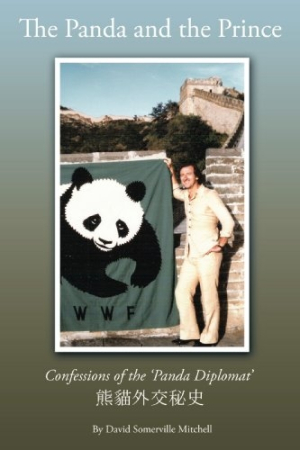The Panda and the Prince
Confessions of the 'Panda Diplomat'
Australian David Somerville Mitchell, one of the foremost public relations practitioners in Asia during the late ’70s and ‘80s, was a logical if bold choice to change the world’s understanding of the aims of the World Wildlife Fund/World Wide Fund for Nature (WWF). His seven years moving the organization to the global forefront of the conservation/environmental activism movement is the subject of The Panda and the Prince.
Mitchell’s narrative is a lively if spotty chronicle of his experiences getting what he termed “Panda Diplomacy” on the agendas of some of the world’s most powerful governments. The ubiquitous WWF logo featuring an image of the black- and-white giant panda wasn’t always such a clear identifier of the organization, nor was the plight of the panda so clearly a distillation and symbol of the global need for action on multiple conservation fronts.
Less a linear narrative than a randomly ordered collection of stories about Mitchell’s machinations, the book still moves at a decent pace. Mitchell weaves interlocking pieces into an interesting mosaic sure to inspire and educate anyone curious about how conservation on a global scale is, perhaps counterintuitively, accomplished not at the grassroots level, but in the highest echelons of power, influence, wealth, and politics.
A few writing flaws rankle, the worst being a lack of dates and the absence of placing the narrative in the larger context of cultural moments. Only by examining dates on several newspapers that appear in photographs can a reader know the events transpiring took place in the early 1980s. Mitchell, a seasoned, detail-obsessed communications professional, must have purposely omitted exact years, leaving readers unfamiliar with the WWF narrative frustrated. Why he also chose, in the final thirty pages or so, to reverse course and include dates in the material summing up more recent developments is also baffling, though welcome.
Many readers will likely be offended by the way Mitchell’s descriptions of virtually all female colleagues—regardless of their positions in the worlds of business, activism, or politics—include terms like “attractive,” “petite,” “blonde,” and “shapely.” This is in distinct contrast to how he depicts his male counterparts, who are invariably “successful,” “powerful,” “well-connected,” “respected,” and “innovative.”
What may be initially construed as heavy-handed name-dropping is instead, it seems, only an accurate account of the big names with whom the author’s job mandated interaction. Appearing on the page are, among others, HRH Prince Phillip Duke of Edinburgh, several Asian Emperors, adventurer Thor Heyerdahl, advertising mogul David Ogilvy, CEOs of corporations like Roche, and some of the wealthiest individuals and scrappiest power-brokers on earth. And while it’s a bit tiresome to read about another lovely dinner at yet another gazillion-dollar chalet, overall this rare peek into how things really get done on a worldwide scale is instructive and intriguing.
Reviewed by
Lisa Romeo
Disclosure: This article is not an endorsement, but a review. The publisher of this book provided free copies of the book and paid a small fee to have their book reviewed by a professional reviewer. Foreword Reviews and Clarion Reviews make no guarantee that the publisher will receive a positive review. Foreword Magazine, Inc. is disclosing this in accordance with the Federal Trade Commission’s 16 CFR, Part 255.

